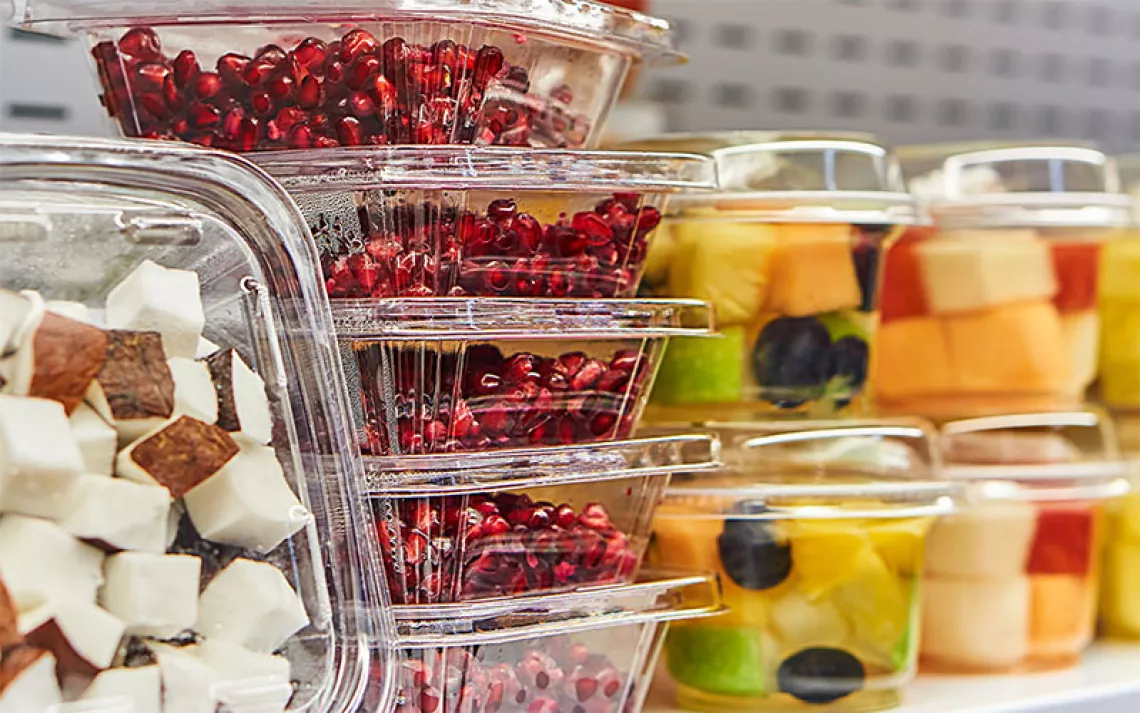The Plastic in Paint Is Massively Polluting the Ocean
A just-released study paints a dire picture

Photo by Rattankun Thongbun/iStock
When I lived in New York City, I often marveled at the massive human effort employed in service of maintaining the city’s aging infrastructure, namely its beautiful bridges. Elaborate, tinker-toy-like sets of scaffolding would emerge around the George Washington, Queensboro, and Manhattan Bridges, seemingly overnight. The scaffolding, in most cases, had not been erected for major structural repair but for routine maintenance—specifically, so that the bridges could be painted. Keeping the George Washington Bridge covered in paint was a 365-day-a-year job. A virtual army of painters in hardhats and harnesses continually scuttled across the span, tight-roping the cables, touching up nicks in the coat with hand rollers dripping silver paint.
The painting was necessary, of course, because the paint itself was in a state of continual decay. I always wondered about the paint that had worn away and fallen into the Hudson and East Rivers. What was the cumulative impact of this industrial rain on the waterways below?
I never found a satisfactory answer to this question—that is, until earlier this month. A report released by the Swiss research firm Environmental Action illustrates the devastating impact of paint—specifically, the plastic within it—on our planet. The study’s findings suggest that paint could be the largest single source of microplastic pollution—accounting for 1.9 million tons, or 58 percent of the total volume—being deposited into the world’s oceans. (This amount, according to the report, vastly exceeds previous estimates of between 9 and 21 percent.) Just as concerning, perhaps, is that of the 18 million tons of plastic contained in paint, 40 percent, or 7.4 million tons, will eventually leak out to the environment. According to an estimate from the World Economic Forum, the number of microplastics that find their way to the ocean every year by way of paint flaking from steel surfaces is equivalent to the plastic of 150 to 225 billion empty plastic bottles.
“This report should be a wake-up call for the paint industry,” said Declan McAdams, chairman of Pinovo, a company that specializes in mitigating pollution from paint and a coauthor of the report, in a press release. “It’s important that the industry finds less harmful and more sustainable alternatives. We need a systemic change in the use and management of paint, now that these findings have shone a light on the extent of the pollution being caused.”
The elastic material in paint was once supplied by natural latex from rubber trees. During World War II, as natural raw materials became increasingly scarce, manufacturers began to introduce synthetic, petroleum-derived materials to their formulas. Today, though many paints still have “latex” on their labels, the word is almost always a misnomer. Most so-called latex paints are composed of more than one-third plastic. These additives make the paint more durable, resistant to water, and washable. But as the paint ages, it dries, cracks and flakes, sending minuscule plastic fragments into the environment.
No place on Earth has been spared the insult of our plastic detritus. These tiny fragments are turning up in the deepest oceans to the highest mountaintops—literally. A 2020 study in the journal One Earth by researchers from the University of Plymouth found microplastic fibers in ice and snow samples taken from the summit of Mt. Everest. In a study from the same year, Australian researchers reported finding microplastics along the seafloor of the Great Australian Bight, on the continent’s south coast, at depths exceeding 10,000 feet. Microplastic is not merely languishing in the environment but is being ingested by organisms at various levels of the food web. Oxford researchers, for example, found microplastics in a host of deep-sea-dwelling organisms, including sea cucumbers, hermit crabs, and lobsters.
Microplastics are turning up everywhere—including inside of us. A 2019 study by researchers in Vienna found an average of 20 pieces of microplastic between 50 and 500 micrometers (human hair, by comparison, is from 17 to 180 micrometers in diameter) in the feces of eight test subjects. Another Chinese study from last year found microplastics in stool samples of 23 out of 25 people tested.
The EA report provides a staggering glimpse of where much of this blizzard of plastic is coming from. Regionally speaking, according to its findings, Asia contributes the greatest proportion, 54 percent, of all paint-derived plastic. The EA study also found that architectural sources—concrete buildings, wood-frame houses, bridges, and other structures—contribute almost half of the overall total of microplastic “leakage.” (This chaff comes from not only the exteriors of buildings but also the interiors.) It is death by a million cuts. Even the seemingly modest amount of paint used in road striping accounts for a full 2 percent of paint-derived plastic pollution.
What can be done? Paint recycling has been available for years but is of little use once the stuff has already been applied to our roads, bridges, buildings, and other pieces of infrastructure. More recently, companies have begun to engineer paints without plastic. One brand, Graphenstone, uses a combination of lime and graphene as a binder instead of plastic. (The company claims that the paint, which contains calcium hydroxide, also absorbs CO2.) But the lion's share of the paint being manufactured today remains loaded with plastic. And with every object—from the George Washington Bridge to our own homes—sheathed in this colorful and friable plastic skin, it’s not a problem that can be solved overnight.
Lest we need to be reminded again in this age of ecological reckoning, the smallest of actions—even the seemingly benign act of dipping a brush in a can of paint—add up.
 The Magazine of The Sierra Club
The Magazine of The Sierra Club



